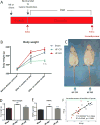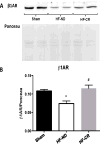Long-Term Caloric Restriction Improves Cardiac Function, Remodeling, Adrenergic Responsiveness, and Sympathetic Innervation in a Model of Postischemic Heart Failure
- PMID: 29535114
- PMCID: PMC5858906
- DOI: 10.1161/CIRCHEARTFAILURE.117.004153
Long-Term Caloric Restriction Improves Cardiac Function, Remodeling, Adrenergic Responsiveness, and Sympathetic Innervation in a Model of Postischemic Heart Failure
Abstract
Background: Caloric restriction (CR) has been described to have cardioprotective effects and improve functional outcomes in animal models and humans. Chronic ischemic heart failure (HF) is associated with reduced cardiac sympathetic innervation, dysfunctional β-adrenergic receptor signaling, and decreased cardiac inotropic reserve. We tested the effects of a long-term CR diet, started late after myocardial infarction on cardiac function, sympathetic innervation, and β-adrenergic receptor responsiveness in a rat model of postischemic HF.
Methods and results: Adult male rats were randomly assigned to myocardial infarction or sham operation and 4 weeks later were further randomized to a 1-year CR or normal diet. One year of CR resulted in a significant reduction in body weight, heart weight, and heart weight/tibia length ratio when compared with normal diet in HF groups. At the end of the study period, echocardiography and histology revealed that HF animals under the CR diet had ameliorated left ventricular remodeling compared with HF rats fed with normal diet. Invasive hemodynamic showed a significant improvement of cardiac inotropic reserve in CR HF rats compared with HF-normal diet animals. Importantly, CR dietary regimen was associated with a significant increase of cardiac sympathetic innervation and with normalized cardiac β-adrenergic receptor levels in HF rats when compared with HF rats on the standard diet.
Conclusions: We demonstrate, for the first time, that chronic CR, when started after HF established, can ameliorate cardiac dysfunction and improve inotropic reserve. At the molecular level, we find that chronic CR diet significantly improves sympathetic cardiac innervation and β-adrenergic receptor levels in failing myocardium.
Keywords: caloric restriction; heart failure; myocardial infarction; receptors, adrenergic; sympathetic nervous system.
© 2018 American Heart Association, Inc.
Figures






Comment in
-
Caloric Restriction as a Therapeutic Approach to Heart Failure: Can Less Be More in (Mice) and Men?Circ Heart Fail. 2018 Mar;11(3):e004930. doi: 10.1161/CIRCHEARTFAILURE.118.004930. Circ Heart Fail. 2018. PMID: 29535115 No abstract available.
Similar articles
-
Exercise promotes angiogenesis and improves beta-adrenergic receptor signalling in the post-ischaemic failing rat heart.Cardiovasc Res. 2008 May 1;78(2):385-94. doi: 10.1093/cvr/cvm109. Epub 2007 Dec 18. Cardiovasc Res. 2008. PMID: 18093988
-
The myocardial beta-adrenergic system in spontaneously hypertensive heart failure (SHHF) rats.Hypertension. 1999 Jan;33(1 Pt 2):402-7. doi: 10.1161/01.hyp.33.1.402. Hypertension. 1999. PMID: 9931137
-
Cardiac resynchronization therapy restores sympathovagal balance in the failing heart by differential remodeling of cholinergic signaling.Circ Res. 2015 May 8;116(10):1691-9. doi: 10.1161/CIRCRESAHA.116.305268. Epub 2015 Mar 2. Circ Res. 2015. PMID: 25733594 Free PMC article.
-
Clinical aspects of left ventricular diastolic function assessed by Doppler echocardiography following acute myocardial infarction.Dan Med Bull. 2001 Nov;48(4):199-210. Dan Med Bull. 2001. PMID: 11767125 Review.
-
The cellular and physiologic effects of beta blockers in heart failure.Clin Cardiol. 1999 Oct;22 Suppl 5:V16-20. Clin Cardiol. 1999. PMID: 10526699 Review.
Cited by
-
Effects of caloric overload before caloric restriction in the murine heart.Aging (Albany NY). 2022 Mar 28;14(6):2695-2719. doi: 10.18632/aging.203967. Epub 2022 Mar 28. Aging (Albany NY). 2022. PMID: 35347086 Free PMC article.
-
Dietary Restriction and Epigenetics: Part I.Cond Med. 2019 Dec;2(6):284-299. Cond Med. 2019. PMID: 32039345 Free PMC article.
-
Amyloid β instigates cardiac neurotrophic signaling impairment, driving Alzheimer's associated heart disease.bioRxiv [Preprint]. 2025 Jun 4:2023.07.11.548558. doi: 10.1101/2023.07.11.548558. bioRxiv. 2025. PMID: 37502936 Free PMC article. Preprint.
-
Heart Failure in Type 2 Diabetes Mellitus.Circ Res. 2019 Jan 4;124(1):121-141. doi: 10.1161/CIRCRESAHA.118.311371. Circ Res. 2019. PMID: 30605420 Free PMC article. Review.
-
Dietary protein restriction throughout intrauterine and postnatal life results in potentially beneficial myocardial tissue remodeling in the adult mouse heart.Sci Rep. 2019 Oct 22;9(1):15126. doi: 10.1038/s41598-019-51654-3. Sci Rep. 2019. PMID: 31641210 Free PMC article.
References
-
- Buggey J, Mentz RJ, Galanos AN. End-of-life Heart Failure Care in the United States. Heart Fail Clin. 2015;11:615–23. - PubMed
-
- Rengo F, Leosco D, Iacovoni A, Rengo G, Golino L, Borgia F, De Lisa G, Beneduce F, Senni M. Epidemiology and risk factors for heart failure in the elderly. Ital Heart J. 2004;5(Suppl 10):9S–16S. - PubMed
-
- Fontana L, Villareal DT, Weiss EP, Racette SB, Steger-May K, Klein S, Holloszy JO Group WUSoMC. Calorie restriction or exercise: effects on coronary heart disease risk factors. A randomized, controlled trial. Am J Physiol Endocrinol Metab. 2007;293:E197–202. - PubMed
-
- Melo DS, Costa-Pereira LV, Santos CS, Mendes BF, Costa KB, Santos CF, Rocha-Vieira E, Magalhães FC, Esteves EA, Ferreira AJ, Guatimosim S, Dias-Peixoto MF. Severe Calorie Restriction Reduces Cardiometabolic Risk Factors and Protects Rat Hearts from Ischemia/Reperfusion Injury. Front Physiol. 2016;7:106. - PMC - PubMed
-
- McGillicuddy FC, Roche HM. Nutritional status, genetic susceptibility, and insulin resistance--important precedents to atherosclerosis. Mol Nutr Food Res. 2012;56:1173–84. - PubMed
Publication types
MeSH terms
Substances
Grants and funding
LinkOut - more resources
Full Text Sources
Other Literature Sources
Medical
Research Materials
Miscellaneous

